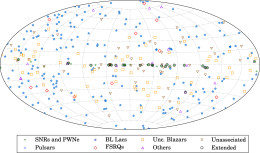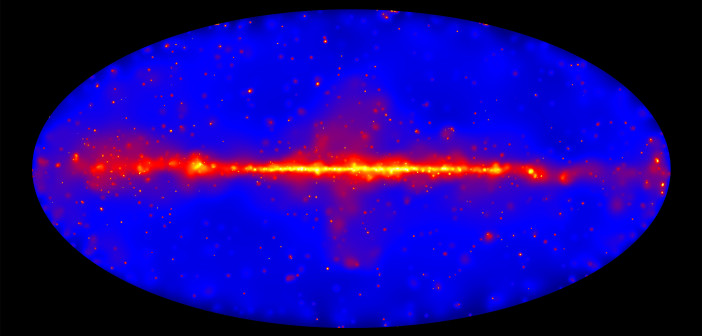The Large Area Telescope (LAT) on board the Fermi Gamma-ray Space Telescope has received an upgrade that increased its sensitivity by a whopping 40% — and nobody had to travel to space to make it happen! The difference instead stems from remarkable improvement to the software used to analyze Fermi-LAT’s data, and it has resulted in a new high-energy map of our sky.

Animation (click to watch!) comparing the Pass 7 to the Pass 8 Fermi-LAT analysis, in a region in the constellation Carina. Pass 8 provides more accurate directions for incoming gamma rays, so more of them fall closer to their sources, creating taller spikes and a sharper image. [NASA/DOE/Fermi LAT Collaboration]
Pass 8
Fermi-LAT has been surveying the whole sky since August 2008. It detects gamma-ray photons by converting them into electron-positron pairs and tracking the paths of these charged particles. But differentiating this signal from the charged cosmic rays that also pass through the detector — with a flux that can be 10,000 times larger! — is a challenging process. Making this distinction and rebuilding the path of the original gamma ray relies on complex analysis software.
“Pass 8” is a complete reprocessing of all data collected by Fermi-LAT. The software has gone through many revisions before now, but this is the first revision that has taken into account all of the experience that the Fermi team has gained operating the LAT in its orbital environment.
The improvements made in Pass 8 include better background rejection of misclassified charged particles, improvements to the point spread function and effective area of the detector, and an extension of the effective energy range from below 100 MeV to beyond a few hundred GeV. The changes made in Pass 8 have increased the sensitivity of Fermi-LAT by an astonishing 40%.
Map of the High-Energy Sky

Sky map of the sources in the 2FHL catalog, classified by their most likely association. Click for a better look! [Ackermann et al. 2016]
- 47 of the sources are new — they have not previously been detected by Fermi or ground-based gamma-ray detectors.
- 86% of the sources can be associated with counterparts at other wavelengths. This includes
- 75% that are active galactic nuclei, and
- 11% that originate in our galaxy, the majority of which are associated with objects at the final stage of stellar evolution, such as pulsar wind nebulae and supernova remnants.
Because the quality of Fermi-LAT’s observations is limited by the number of photons collected, longer observing time will only serve to improve the detections in this catalog. And since only 22% of the 2FHL sources have been observed by ground-based gamma-ray detectors (which have much more limited fields of view), this catalog provides an excellent list of candidates that these detectors can now follow up at very high energies.
Bonus
Want to learn more about Pass 8? Check out this video, created by the Fermi team. [NASA’s Goddard Space Flight Center]
Citation
M. Ackermann et al 2016 ApJS 222 5. doi:10.3847/0067-0049/222/1/5

2 Comments
Pingback: software improvement makes FERMI more sensitive
Pingback: Found: A Galaxy’s Missing Gamma Rays